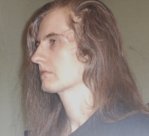I finished Richard Dawkins' The Selfish Gene a while back. It confirmed many of my previous insights, and provoked new ones. One interesting thing about selfish gene theory is that it calls into question the nature of the self.
Indeed, "the" self may itself be a misnomer. The standard usage in the West is to define self as single, discrete and unified: You either are or are not something. Yet, biology calls this into question, not only for other living creatures but for our own selves as well.
Biologically, self and other are not a dichotomy but a continuum. The more genes that two or more organisms, or pieces of protoplasm, have in common, the more closely they are related, and the more they will act as if they share a common identity. Some well-known examples of this are kin-selection resulting in altruism between kin, even to the point of self-sacrifice; the hive-minds of the social insects; asexual lifeforms which reproduce by budding and fission, and for which reproduction is indistinguishable from growth; clonal organisms which form identical duplicates; and the incorporation of endosymbionts, such as the mitochondria in our cells, into their host organisms. An organism itself is a colony of individual cells. Each of these illustrates a different way in which some degree of common selfhood is distributed among multiple organic forms, multiple bodies, and multiple lives.
Viewed through a biological lens, selfhood is a "fuzzy set". Self shades gradually into other through degrees of relatedness, which are determined by shared information content -- genes and other replicators. (From a Vitalistic standpoint, one can also speak of shared will and intent. I will expand on this later.) In this sense, biological identity is cladistic: formed of interconnected clusters.
"Clade" means "branch" or "cluster"; in biological science, Cladism is a system of classifying organisms in terms of relatedness and lines of descent rather than in fixed, hierarchical categories as in the old system of Linnaean Taxonomy. I shall employ the term in a more general sense, to refer to the overall concept of identity as composed of partially overlapping clusters of information, energy, and will. In the Cladist vision, individuality is not a mere illusion; the information patterns which compose self are real, particular and unique. But self is, for all that, neither discrete nor atomistic; it is fluid and without fixed boundaries.
Here is a notion of self-identity which is not bounded by the skin, nor limited to the conscious ego. How does this relate to traditional concepts of nondualism, as in Eastern mysticism?
The concepts are similar, but not quite identical. Nondualism is generally seen as an absolute, rather than a matter of degree. Things simply are nondual, not more or less so. It is often expressed in paradoxical language such as "not one, not two", or "the sound of one hand clapping." By contrast, nondiscrete identity is a matter of degree and percentage. You can overlap with something a little or a lot, and with some things more than others.
Putting it metaphorically: duality is the sound of two hands clapping, nonduality is the sound of one hand clapping, and nondiscreteness is the sound of one-and-a-half hands clapping.
Are these two views incompatible? Not necessarily. They can be seen as belonging to different levels of reality. In Kashmir Shaivism, there is a graduated series of states or phases called tattwas which mediate between pure unity and duality. In the "triple-decker" cosmos of the Integral Paradigm, a similar collection of phenomena occupies the intermediate level. the Subtle plane, realm of the soul and psyche. Plants and animals have their own equivalent of this, as varying expressions of conscious Life- Force. Elias and Seth both describe consciousness at this level as organized in complex, clustered structures, analogous to lines of biological descent, called essence families or families of consciousness.
Even on the conscious level, it is not uncommon to have intermittent experiences of partial nonduality, and some people experience it frequently as a natural state -- for example, those who identify as median/ midcontinuum. Elias describes a similar concept which he terms dispersed essence. As humans become more open to alternate levels of consciousness, we will no doubt all gain more flexible, open and free notions of selfhood.
Ayn Rand, the Individual and Selfishness
13 years ago

No comments:
Post a Comment